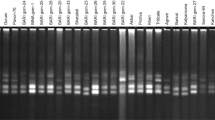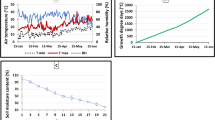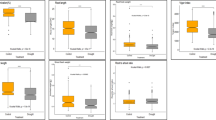Abstract
Polyethylene glycol and cell membrane stability (CMS) assay were used to evaluate drought and heat tolerance, respectively, among 14 wheat lines based on seedling traits and molecular analysis. Significant variation was evidenced for all the investigated seedling traits. Different levels of heritability and genetic advance were found among the tested traits, indicating whether the trait is controlled by additive or non-additive gene action. Drought caused a significant reduction in root and shoot lengths. However, root/shoot ratio under drought stress was increased. Root length showed a highly significant negative correlation with drought susceptibility index (DSI) under drought conditions. Cluster analysis based on seedling traits separated lines mainly by DSI and CMS. Some lines showed drought and heat tolerance by exhibiting a low DSI with high CMS. Sequence-related amplified polymorphism (SRAP) generated a total of 135 bands, with a level of polymorphism ranging from 30 to 86% among the tested lines. SRAP showed its efficiency in discriminating wheat genotypes by gathering all high-DSIlines in one sub-cluster and generating 10 and 3 unique and specific bands for high-DSI-lines and low-DSI-lines, respectively. These bands could be used for further work as SRAP markers associated with drought tolerance in wheat.
Similar content being viewed by others
References
Ahmad M, Shabbir G, Minhas NM, Shah MKN. 2013. Identification of drought tolerant wheat genotypes based on seedling traits. Sarhad J. Agric. 29: 21–27
Al-Doss AA, Elshafei AA, Moustafa KA, Saleh M, Barakat MN. 2011. Comparative analysis of diversity based on morphoagronomic traits and molecular markers in durum wheat under heat stress. Afr. J. Biotech. 10: 3671–3681
Al-Doss AA, Saleh M, Moustafa KA, Elshafei AA, Barakat MN. 2010. Grain yield stability and molecular characterization of durum wheat genotypes under heat stress conditions. Afr. J. Agric. Res. 5: 3065–3074
Allard R. 1964. Principles of Plant Breeding, John Wiley and Sons Inc, New York, London
Atchison J, Head L. 2010. Wheat as food, wheat as industrial substance: comparative geographies of transformation and mobility. Geoforum 41: 236–246
Bai C, Liang Y, Hawkesford MJ. 2013. Identification of QTLs associated with seedling root traits and their correlation with plant height in wheat. J. Exp. Bot. 64: 1745–1753
Blum A, Ebercon A. 1981. Cell membrane stability as a measure of drought and heat tolerance in wheat. Crop Sci. 21: 43–47
Budak H, Shearman RC, Parmaksiz I, Gaussoin RE, Riordan TR, Dewiak I. 2004. Molecular characterization of buffalograss germplasm using sequence-related amplified polymorphism markers. Theor. Appl. Genet. 108: 328–334
Burton GW. 1952. Quantitative inheritance in grasses. Proceedings of the 6th International Grassland Congress, August 17-23, 1952. Pennsylvania State College, USA, pp 277–283
Dellaporta SL, Wood J, Hicks JB. 1983. A plant DNA minipreparation: version II. Plant Mol. Biol. Rep. 1: 19–21
Dong P, Wei Y, Chen G, Li W, Wang J, Nevo E, Zheng Y. 2010. Sequence-related amplified polymorphism (SRAP) of wild emmer wheat (Triticum dicoccoides) in Israel and its ecological association. Biochem. Syst. Ecol. 38: 1–11
Eid MH. 2009. Estimation of heritability and genetic advance of yield traits in wheat (Triticum aestivum L.) under drought condition. Int. J. Genet Mol. Biol. 1: 115–120
Eivazi AR, Naghavi MR, Hajeidari M, Pirseyedi SM, Ghaffari MR, Mohammadi SA, Majidi I, Salekedeh GH, Mardi M. 2007. Assessing wheat (Triticum aestivum L.) genetic diversity using quality traits, amplified fragment length polymorphism, simple sequence repeats and proteome analysis. Ann. Appl. Biol. 152: 81–91
El-Mouhammady AA, Rady MR, El-Seidy EH. 2014. Assessment of genetic variability for six lines of wheat using physiological traits and molecular markers technique under normal irrigation and water stress conditions. World Appl. Sci. J. 29: 506–516
Elshafei AA, Saleh M, Al-Doss AA, Moustafa KA, Al-Qurainy FH, Barakat MN. 2013. Identification of new SRAP markers linked to leaf chlorophyll content, flag leaf senescence and cell membrane stability traits in wheat under water-stressed condition. Aust. J. Crop Sci. 7: 887–893
El Siddig MA, Dweikat I, Baenziger S, El Hussein AA, Elbasyoni I. 2013. Genetic diversity among Sudanese wheat cultivars as revealed by molecular markers. Middle-East J. Sci. Res. 14: 1135–1142
Ferriol M, Pico B, Nuez F. 2003. Genetic diversity of a germplasm collection of Cucurbita pepo using SRAP and AFLP markers. Theor. Appl. Genet. 107: 271–282
Fischer RA, Maurer R. 1978. Drought resistance in spring wheat cultivars: 1. Grain-yield responses. Aust. J. Agric. Res. 29: 897–912
Gregory PJ. 2006. Roots and the architecture of root systems. In: Roots: Growth, Activity and Interactions with Soils. Oxford, Blackwell, pp 18–44
Han XY, Wang LS, Liu ZA, Jan DR, Shu QY. 2008. Characterization of sequence-related amplified polymorphism markers analysis of tree peony bud sports. Sci. Hort. 115: 261–267
Jaccard P. 1908. Nouvelles recherches sur la distribution florale. Bull. Soc. Vaud. Sci. Nat. 44: 223–270
Johnson HW, Robinson HF, Comstock RE. 1955. Estimates of genetic and environmental variability in soybean. Agron. J. 47: 314–318
Khan N, Naqvi FN. 2011. Heritability of morphological traits in bread wheat advanced lines under irrigated and non-irrigated conditions. Asian J. Agric. Sci. 3: 215–222
Lagerwerff JV, Ogata G, Eagle HE. 1961. Control of osmotic pressure of culture solutions with polyethylene glycol. Science 133: 1486–1487
Li G, Quiros CF. 2001. Sequence-related amplified polymorphism (SRAP), a new marker system based on a simple PCR reaction: its application to mapping and gene tagging in Brassica. Theor. Appl. Genet. 103: 455–461
Lobell DB, Schlenker W, Costa-Roberts J. 2011. Climate trends and global crop production since 1980. Science 333: 616–620
Nissen O. 1984. MSTAT. A microcomputer program for statistical analyses of experiments and surveys. In H Riley, AO Skjelvag, ed, The impact of climate on grass production and quality. Proc. General Meet Eur. Grassl. Fed., 10th, As, Norway. 26–30 June 1984. Norwegian State Agric. Res. Stations, As, pp 555–559
Rauf M, Munir M, Hassan M, Ahmad M, Afzal M. 2006. Performance of wheat genotypes under osmotic stress at germination and early seedling growth stage. Afr. J. Biotech. 6: 971–975
Roy SJ, Tucker EJ, Tester M. 2011. Genetic analysis of abiotic stress tolerance in crops. Curr. Opin. Plant Biol. 14: 232–239
Salem KFM, El-Zanaty AM, Esmail RM. 2008. Assessing wheat (Triticum aestivum L.) genetic diversity using morphological characters and microsatellite markers. World J. Agric. Sci. 4: 538–544
Sardana S, Mahjan R, Gautam N, Ram B. 2007. Genetic variability in pea (Pisum sativum L.) germplasm for utilization. SABRAO J. Breed. Genet. 39: 31–41
Shafeeq S, Rahman M, Zafar Y. 2006. Genetic variability of different wheat (Triticum aestivum L.). Pak. J. Bot. 38: 1671–1678
Shiferaw B, Smale B, Braun H-J, Duveiller E, Reynolds M, Muricho G. 2013. Crops that feed the world 10. Past successes and future challenges to the role played by wheat in global food security. Food Sec. 5: 291–317
Singh GP, Chaudhary HB, Rajbir Y, Tripathi S. 2008. Genetic analysis of moisture stress tolerance in segregating populations of bread wheat (T. aestivum L.). Ind. J. Agric. Sci. 78: 848–852
Singh RK, Chaudhary BD. 1985. Biometrical methods in quantitative genetic analysis. Kalyani, New Delhi
Soliman HIA, Hendawy MH. 2013. Selection for drought tolerance genotypes in durum wheat (Triticum durum Desf.) under in vitro conditions. Middle-East J. Sci. Res. 14: 69–78
Stulnig TM, Amberger A. 1994. Exposing contaminating phenol in nucleic acid preparations. BioTechniques 16: 403–404
Tyagi K, Park MR, Lee HJ, Lee CA, Rehman S, Steffenson B, Yun SJ. 2011. Fertile crescent region as source of drought tolerance at early stage of plant growth of wild barley (Hordeum vulgare L. Ssp. Spontaneum). Pak. J. Bot. 43: 475–486
Valdez-Ojeda R, James-Kay A, Ku-Cauich J, Escobedo-GraciaMedrano RM. 2014. Genetic relationships among a collection of Musa germplasm by fluorescent-labled SRAP. Tree Genet. Genomes 10: 465–476
Wu Y, Cosgrove DJ. 2000. Adaptation of roots to low water potentials by changes in cell wall extensibility and cell wall proteins. J. Exp. Bot. 51: 1543–1553
Yi YJ, Liu HY, Huang XQ, An LZ, Wang F, Wang XL. 2008. Development of molecular markers linked to the wheat powdery mildew resistance gene Pm4b and marker validation for molecular breeding. Plant Breed. 127: 116–120
Youssef M. 2012. Khirshyat 1.0: a simple micro-program for some molecular biology protocols. Genes, Genom. Genomics 6: 102–105
Zaefizadeh M, Goliev R. 2009. Diversity and relationships among durum wheat landraces (subconvars) by SRAP and phenotypic marker polymorphism. Res. J. Biol. Sci. 4: 960–966
Author information
Authors and Affiliations
Corresponding author
Rights and permissions
About this article
Cite this article
El-Rawy, M.A.E., Youssef, M. Evaluation of drought and heat tolerance in wheat based on seedling traits and molecular analysis. J. Crop Sci. Biotechnol. 17, 183–189 (2014). https://doi.org/10.1007/s12892-014-0053-x
Received:
Revised:
Accepted:
Published:
Issue Date:
DOI: https://doi.org/10.1007/s12892-014-0053-x




